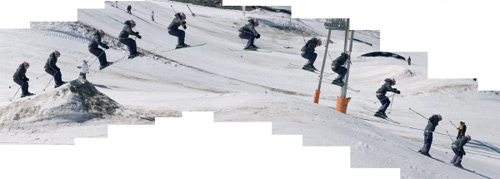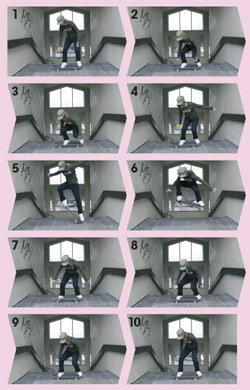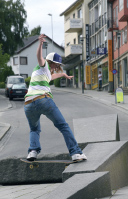Can’t spin on a board, fear the big kickers on skis, yet to ollie on a skateboard? We’ve asked the experts to get you unstuck from the rut and riding at the next level.
Snowboard Expert

Katrin Eckerstorfer, camp director and head snowboard coach at Girlie Camps (www.girliecamps.com)
Vital stats: 25-year-old Katrin started snowboarding when she was 10 and coaching when she was just 18. Although she competed in big air and boarder x comps, her calling so far in life has been to teach girls to ride and have fun. Katrin has been the camp director at Girlie Camps since 2004.
Q: ‘I’ve been snowboarding for four weeks now, but I’m still not brave enough to spin. My friends can all do 180s and 360s and they look so cool jibbing around on the piste. It looks wicked fun, and I want to join them. Can you help?’ Emma

A: First of all, don’t feel stressed about being scared of spinning. It took me a while to get over it. The most important thing is that you feel confident on your board. If your aim is to hit the park, start to play around on the slopes, rather than just hitting cruise control from top to bottom.
Start Jibbing
Ollies are the building block for spins and tricks, so practise them over every little bump you see. Approach the bump flat, load up the tail, pop up in the air, bring both legs up
and stomp down flat. Second thing is to get confident riding switch, not just two linked turns in a flat part, but carving down switch on a steep slope. Practise enough so that it feels natural riding normal and switch. The better you are at these skills the easier it will be to nail harder tricks later on.
Start Spinning
Before you start spinning in the park, be happy doing frontside and backside 180s on the slopes at a normal speed. The more you practise on the pistes the easier it will be over the kickers. So, instead of doing just an ollie over the next bump you see, go for a backside 180. The most important thing to remember for this trick is that your body will always follow your eyes. With this in mind, keep your board flat on the approach and bend your knees low. When you hit the bump, spring off your toe edge and look in the direction you want to go (i.e. behind you!). As you start the rotation your arms will support you and your body will follow your head. Look between your legs for your landing spot and then plant or ‘stomp’ your board flat, bending your knees low to complete the spin. Look ahead and ride out switch.
Now, try a frontside 180, springing off on your heels as you hit the bump, and looking ahead to make the turn. Practise these spins over and over on the slopes at a normal speed until you feel ready to hit the bigger kickers. If you go to the park too early, you’ll end up getting frustrated or hurt, so just enjoy jibbing and taking the time to build skills.
Park and Ride
Start with a couple of straight jumps off an easy kicker in the park and get a feeling for the take off and landing, then try a frontside 180. If you bend your knees on the approach, look in the direction you want to go, and let your body follow your eyes, nothing can go wrong! The more confident you feel, the bigger you’ll go. Try backside next.

Pimp Your Style
In snowboarding, style is everything. Pimp your 180s by doing all kinds of grabs. For the indy, grab the middle of your board with the back hand. For the mute, grab the middle
of your toe edge with the front hand, or try nose and tail grabs. Watch park riders for tweaking tips.
The natural progression from a 180 is the 360, where your body follows your head in a full circle. For the 360, it’s very important to put more power into the take off and be
really active when you rotate.
Top Spinning Tips
1. Get good at jibbing first.
2. Stomp plenty of spins at full speed on the slopes before you hit the park.
3. Look where you want to go and your body will follow your eyes.
Emma, play around on the mountain, become a good jibber, and the rest will come by itself. Good luck for the season and see you out there rocking!
Katrin
Ski Expert

Sandra Söderin, camp manager and ski coach for Girlie Camps.
Vital stats: 29-year-old Sandra lives in Åre, Sweden, and has been skiing since she was five. After a brief spell snowboarding in her teens, she returned to two planks, got sponsored and lived life as a ski pro for most of her 20s. Sandra’s now an instructor with Girlie Camps.
Q: ‘I’m a confi dent skier on the piste, but as soon as I hit the park, my legs turn to jelly. Can you help me attack a kicker with confidence, and really stomp it!’ – Kamila

Hi Kamila. You’re a long way from being a beginner, and you clearly have plenty of confidence and good technique on piste, so try to focus on these qualities when you ride the park. Also, to help you feel less intimidated, bring some friends with you. Laughter is your best friend to overcome fears.
Easy Kickers
Some resorts have beginner parks while others have terrain parks with lines of blue (easy), red (difficult) and black (expert) kickers, marked by flags. Head to the easy kickers, so you don’t scare yourself or get injured on your first go. Ideally, start on a table-top jump where the take off and landing are at the same level. Ride right over the tabletop – without getting airborne – to become friends with it first. If there’s no tabletop, choose an easy kicker.

Learning to Fly
You want to approach the kicker with the right amount of speed so you clear the table-top and land on the downhill part, not the flat part, of the jump. Look at how fast other skiers are hitting it and try to match their speed. Don’t look at the daredevils! It’s easier to keep your balance if you hit the jump straight on, so be brave and don’t do any speed check turns before take off. On the approach, bend your knees, not your hips, to help you stay balanced. As you take off, keep your head up, your knees tucked and look at the end of the kicker, or the landing if you can see it. Keep your body together as a neat little package, and try not to throw your hands up or stretch out your legs in the air. Spot the landing and hit the ground smoothly with your knees bent and your weight evenly over both feet. Ride away with a big smile. Try to avoid bending from the hips as you land. If you land on your toes or your nose, that’s why!
Grab it, tweak it!
When you’re cruising the small kickers as comfortably as you are the piste, you’re ready to hit the big kickers. Use the same thinking and approach, but now it’s even more important to bend your legs so you don’t get hurt. Keeping your knees bent makes it easier for you to bring your skis up to your hands, so get grabbing as soon as you feel confident. An easy grab is to twist your legs slightly towards the left or right side of you, and grab just under your foot or behind the binding on the ski. Or maybe go for the Japan-air, where you stretch out your left leg and bend your right leg in under your body so you can grab under your right foot with your left hand.
Top Tips for Big Airs
1. Look at other skiers to get the right amount of speed for the landing.
2. Bend your knees.
3. This is not a matter of life and death, so have fun!
Best of luck!
Sandra
Skateboard Expert

Kristina Westad, etnies skater girl
Vital stats: Nicknamed the viking, Kristina from Molde in Norway, was this year’s runner-up at the etnies Push Jam European Open in Munich. Although she’s been skating ‘forever’, the 17-year-old queen of kickflips is a relative newcomer to the pro circuit and is loving life as an etnies girl.
Q: ‘I’m comfortable riding my skateboard, but am keen to bag some cool tricks. I want to nail the ollie, but just can’t suss the technique.’ – Lisa

Hi Lisa. The ollie is the most basic trick you can learn on a skateboard (besides turning, pumping etc.). Once you’ve learnt it, the skateboarding door is open and you can use it for every kind of trick. The ollie consists of making your board join you while you jump straight up into the air.
Ollie Up
First up, make sure your feet are placed in an ollie position on your board. Your back foot should be at the end of the tail and your front foot should be right behind the back bolts of your front truck (pic 1). To start the ollie, bend down and get ready to jump, then push your back foot down at the same time as you lift your front foot up. At the moment the tail of the board hits the ground, push your ankle up against the nose. This movement makes your board pop into the air. Keep your body and feet centred over your board when it’s off the ground, and on the landing bend your knees down low.
Flip Tricks
Once you’ve got the technique down, a whole bag of tricks can be yours. I’d move on to the fliptricks. For the kickflip, you do the ollie, but instead of pushing your foot straight
against the nose, you kick your foot out to the side of your board to make it flip.
Nose Slides
To learn frontside noseslides you need to be able to do an ollie and, at the same time, do a 90 degree turn against the curb or ledge. When you’re in the 90 degree ollie position, move your foot up to the nose and keep it there until you hit the curb or ledge. When you hit it, push your front foot down to lock the nose on the curb, and keep that position while you slide.
Top Tips for The Ollie
1. Trust your board
2. Have confidence in yourself
3. Freakin’ do iT!
Happy riding!
Kristina

Back to Basics
If you’re just starting out on a skateboard, here’s how to escape the ruts early on.
The most important thing to learn when you want to go fast is that your front foot should be pointing straight forwards on the board as you kick with your back foot. This gives you more control and makes your board go straight. Then, when you put your back foot on your board to skate, turn your front foot across your board. Again, this will keep you in control. Don’t use your front foot for kicking, that’s what’s called “mongo”. You can’t go as fast, you lose control and it seriously looks bad!

